#South Gironde
Explore tagged Tumblr posts
Text
10th part of the bookscans of Al Andalus. Historical Figures, here's the previous part
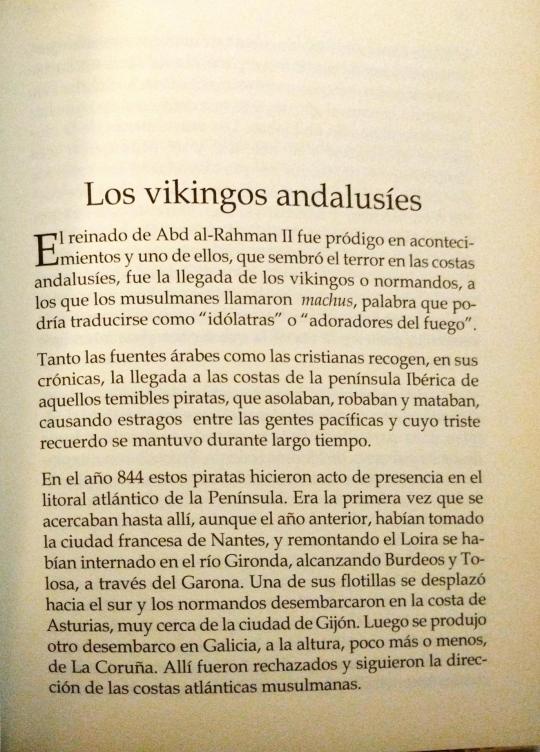
The Andalusian Vikings
The reign of Abd al-Rahman II was rich in events and one of them, that spread terror on the Andalusian coasts, was the arrival of the Vikings or Normans, whom the Muslims called machus, a word that could translate as “idolaters” or “fire worshipers.”
Both Arab and Christian sources record, in their chronicles, the arrival to the coasts of the Iberian Peninsula from those fearsome pirates, who devastated, robbed and killed, wreaking havoc among the peaceful people and whose sad memory remained for a long time.
In the year 844 these pirates made an appearance on the Atlantic coast of the Peninsula. It was the first time they had come there, although the year before, They had taken the French city of Nantes, and going up the Loire they had entered the Gironde River, reaching Bordeaux and Toulouse, through the Garonne.
One of their fleets moved south and the Normans landed in the coast of Asturias, very close to the city of Gijón. Then there was another disembark in Galicia, at the height, more or less, of A Coruña. There they were rejected and followed the direction of the Muslim Atlantic coasts.
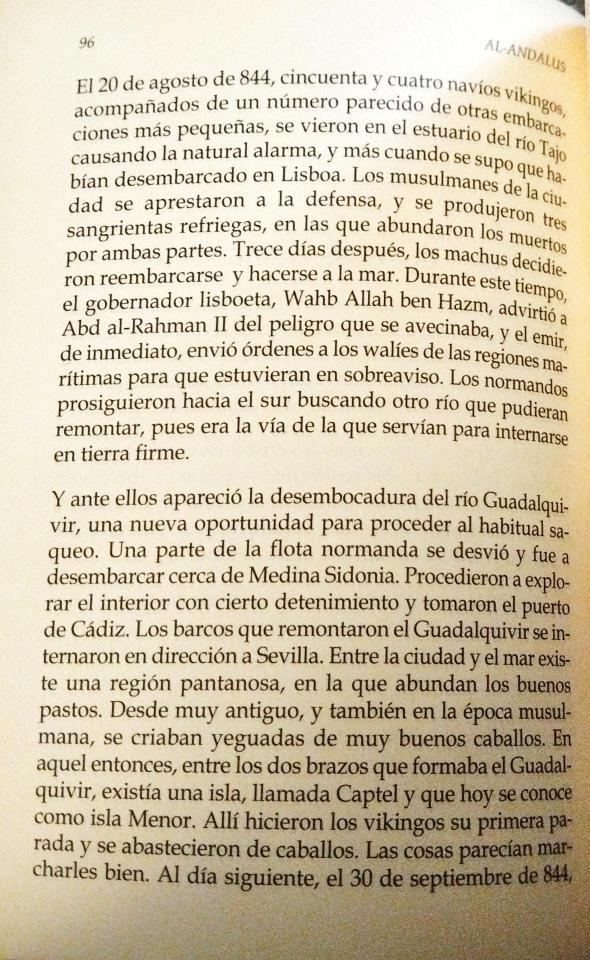
On August 20, 844, fifty-four Viking ships, accompanied by a similar number of other smaller vessels were seen in the estuary of the Tagus River causing natural alarm, and even more so when it was learned that they had landed in Lisbon. The Muslims of the city prepared the defense, and there were three bloody skirmishes, in which there were many dead on both sides. Thirteen days later, the Machus decided reembark and put to sea. During this time, the Lisbon governor, Wahb Allah ben Hazm, warned Abd al-Rahman II of the danger ahead, and the emir immediately sent orders to the walis of the maritime regions so that they were on notice. The Normans continued south looking for another river that they could go up, since it was the route they used to go into dry land.
And before them appeared the mouth of the Guadalquivir river, a new opportunity to proceed with the usual looting. A part of the Norman fleet diverted and landed near Medina Sidonia. They proceeded to explore the interior at some length and took the port of Cádiz. The ships who went up the Guadalquivir headed towards Seville. Between city and the sea there is a swampy region, in which there are good pastures. Since ancient times, and also in Muslim times, they were raised studs of very good horses. Back then, between the two arms that formed the Guadalquivir, there was an island, called Captel and which today is known as Minor Island. There the Vikings made their first stop and supplied themselves of horses. Things seemed to be going well. The next day, the 30th September 844,
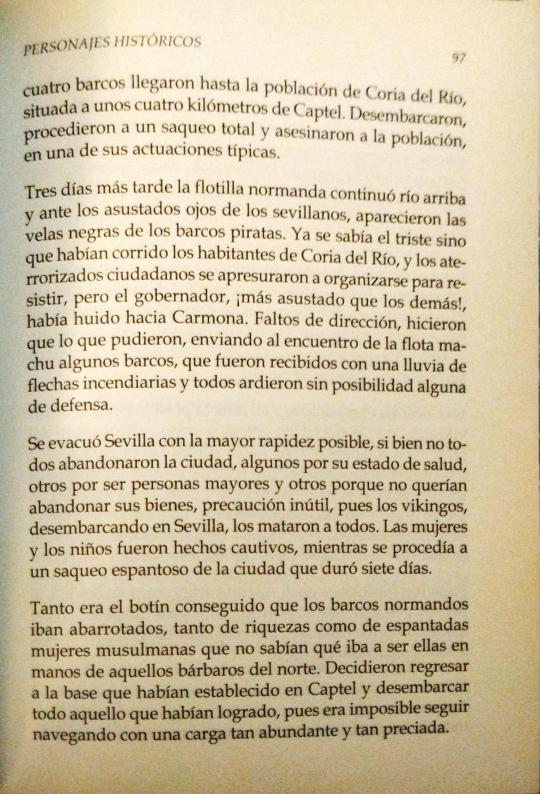
Four ships reached the town of Coría del Río, located about four kilometers away from Captel. They disembarked, proceeded to total looting and murdered the population, in one of their typical performances.
Three days later the Norman fleet. continued upriver and before the frightened eyes of the Sevillians, the black sails of the pirate ships appeared. The sad fate of the inhabitants of Coria del Río was known, and the terrified citizens rushed to organize themselves to resist, but the governor, no more scared than the others!, had fled towards Carmona. Lacking direction, they did what they could, sending to meet the machus' fleet some ships, which were received with a shower of incendiary arrows and they all burned without any possibility of defense.
Seville was evacuated as quickly as possible, although not everyone left the city, some because of their health status, others because they are elderly and others because they did not want to abandon their property, a useless precaution, since the Vikings, landing in Seville, killed them all. Women and children were taken captive, while a horrific looting of the city was carried out, which lasted seven days.
So much loot was obtained that the Norman ships were overcrowded, so much of wealth and of frightened Muslim women who did not know what was going to happen to them in the hands of those barbarians from the north. They decided to return to base that they had established in Captel and disembark everything they had achieved, it was impossible to continue sailing with such an abundant and precious cargo.
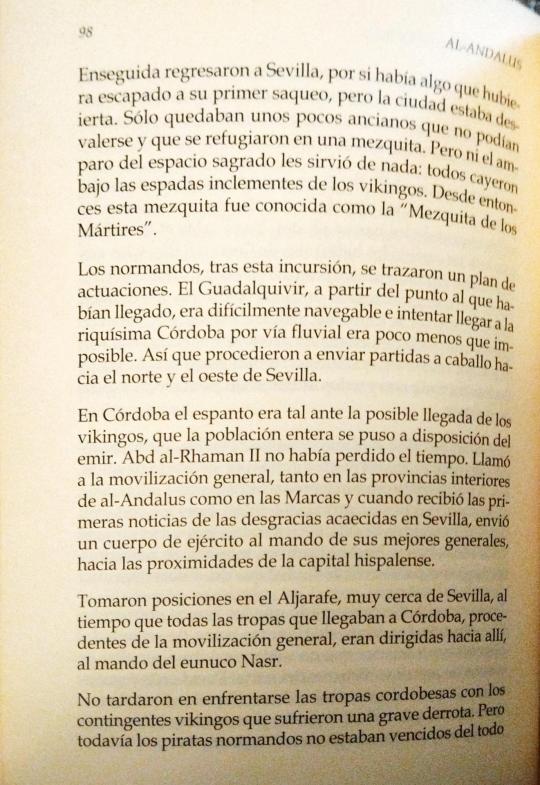
They immediately returned to Seville, in case there was anything that had escaped their first looting, but the city was deserted. There were only a few old people left who did not could help themselves and took refuge in a mosque. But not even the protection of sacred space was of no use to them: they all fell under the merciless swords of the vikings. Since then this mosque was known as the "Mosque of the Martyrs".
The Normans, after this raid, drew up a plan of action. The Guadalquivir, from the point they had reached, was difficult to navigate and trying to reach the rich Córdoba by river was almost impossible. So they proceeded to send horse parties to the north and west of Seville.
In Córdoba the fear was such at the possible arrival of the Vikings, that the entire population was placed at the disposal of the emir. Abd al-Rhaman II had not lost time. He called for general mobilization, both in the interior provinces of Al Andalus and in the Marches and when he received the first news of the misfortuned events in Seville, he sent an army under the command of his best general, towards the outskirts of the capital of Seville.
They took up positions in Aljarafe, very close to Seville, while all the troops arriving in Córdoba, from the general mobilization, were headed there, under the command of the eunuch Nasr.
It didn't take long for the Cordoban troops to clash with the Viking contingents that suffered a serious defeat. But still the Norman pirates were not completely defeated
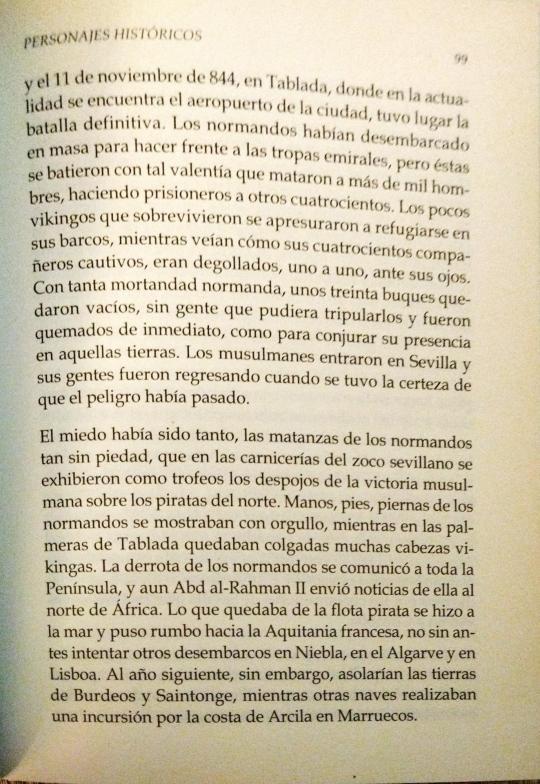
and on November 11, 844, in Tablada, where the city airport is nowadays located, the final battle took place. The Normans had landed en masse to confront the emiral troops, but they fought with such bravery that they killed more than a thousand men, taking prisoners to another four hundred. The few Vikings who survived rushed to take refuge in their ships, while they saw how their four hundred companions captives, their throats were beheaded, one by one, before their eyes. With so much Norman mortality, about thirty ships were left empty, without people who could man them and they were burned immediately, as if to ward off their presence in those land. The Muslims entered Seville and its people returned when it was certain that the danger had passed.
The fear had been so great, the massacres of the Normans so mercilessly, that in the butcher shops of the Sevillian souk, the remains of the Muslim victory over the northern pirates were shown as trophies. Normans hands, feet, legs, were showed with pride, while in the palm trees of Tablada many Viking heads were left hanging. The defeat of the Normans was communicated to the entire Peninsula, and even Abd al-Rahman II sent news of it to North Africa. What remained of the pirate fleet put to sea and headed towards the French Aquitaine, but not before attempting other landings in Niebla, in the Algarve and in Lisbon. The following year, however, they would ravage the lands of Bordeaux and Saintonge, while other ships made a raid along the coast of Asilah in Morocco.
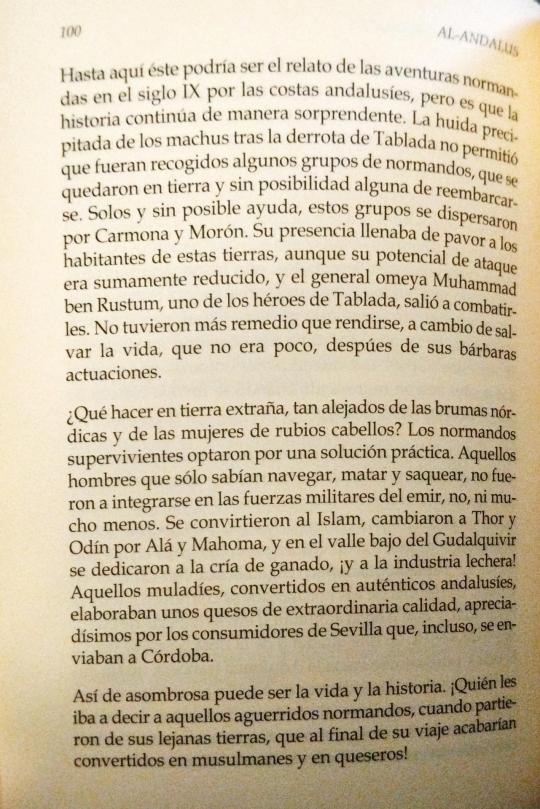
Up to this point this could be the story of the Norman adventures in the 9th century along the Andalusian coasts, but the story continues in an amazing way. The hasty flight of the Machus after the defeat of Tablada did not allow some groups of Normans to be collected, whichwere left on land and without any possibility of reembarking. Alone and without possible help, these groups dispersed through Carmona and Morón. Their presence filled the inhabitants of these lands with dread, although its potential for attack was extremely small, and the Umayyad general Muhammad ben Rustum, one of Tablada's heroes, went out to fight them. They had no more choice but to surrender, in exchange for saving one's life, which was no small thing, after their barbaric actions.
What to do in a strange land, so far from the Nordic mists and the women with blonde hair? The surviving Normans opted for a practical solution. Those men who only knew how to navigate, kill and loot, they were not going to join the emir's military forces, no, not at all. They converted to Islam, changed Thor and Odin for Allah and Muhammad, and in the lower valley of the Gudalquivir they dedicated themselves to cattle raising, and to milk industry! Those muladíes, converted into authentic Andalusians, made cheeses of extraordinary quality, greatly appreciated by consumers from Seville that were even sent to Córdoba.
That's how amazing life and history can be. Who was going to tell those brave Normans, when they left their distant lands, which at the end of their trip they would end up becoming Muslims and cheese makers!
#al andalus historical figures#al andalus personajes históricos#book scans#bookblr#historyblr#al andalus#al andalus history#emirate of cordoba#emirato de córdoba#history#andalusian vikings#vikingos andalusíes#spanish history#muhammad ibn rustum#nars#abd al rahman ii#abd al rahman ii of córdoba#nars abul-fath
12 notes
·
View notes
Text
In Saint-Léon close to Bordeaux is located a “laboratory” that gives new life to plastic waste
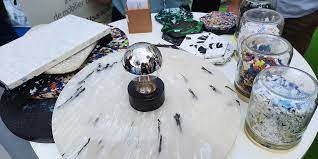
At the crossroads of contemporary design and the circular economy, the Plastiquerie manufactures sustainable furniture from recycled plastic.
So what do the big yellow and blue bags from Ikea or the construction helmets from the manufacturer Vinci have in common? They are made of a plastic material that can be recycled to make new objects. “Recycled plastic is a material with endless possibilities that I want to make known to designers. It’s a bit like the marble of the Anthropocene”, explains Julie Robert, co-founder of La Plastiquerie [1] based in Saint-Léon[2], about thirty kilometres south-east of Bordeaux.
Shelves, furniture or floor tiles
Since 2021, the independent artistic director has been passionate about this raw material, she has learned the properties of in order to manufacture designer objects and furniture. The association recovers plastic waste in polypropylene (PP)[3], polyethylene (PE)[4] or polystyrene (PS)[5] to give them a second life. “PET[6] waste such as plastic bottles already benefit from recycling solutions. I focus on families of plastics that are still poorly revalued”, she specifies. Protective films, water tubes from construction sites or industry off-cuts from yoghurt pots are thus treated in a 100 m² workshop housed in the premises of the Syndicate of the Entre-deux-Mers-West-region for the Collection and Treatment of Household Waste[7].
There, under a sheet metal shed, a shredder and a hot press transform the collected waste into confetti and then into large recycled plastic plates that will be used to make shelves, furniture or floor tiles. “La Plastiquerie is a laboratory where we develop prototypes of objects resulting from the recovery of plastic. From cans and flowerpots, for example, I imagined a wall light that saves 980 grams of plastic from landfill and incineration,” explains the entrepreneur.
"Companies want to recycle their own waste"
Although the Plastiquerie was co-founded with another woman, Amandine Boutang, Julie Robert now works alone, sometimes helped by an intern and supported by a board of directors, on her experiments with furniture designed in recycled and recyclable plastic. She is thinking about a waste sorting cabinet for the canteen of the Suez[8] headquarters in Occitanie-Nouvelle Aquitaine[9]. For the Bordeaux start-up Arits[10], she is working on the design of a lamp. A bank has also just approached her for an interior design project…
"Companies come naturally to the association because they want to recover their own waste or participate in the circular economy", rejoices the forty-year-old who wants to sharpen her expertise on recycled plastic to convince designers to adopt it. Two years after the launch of her project, Julie Robert draws a positive balance sheet: “I discovered the world of the circular economy where the actors are positive, imaginative people, full of energy and solutions. A world in which a great breath of optimism is sweeping in which I find myself.”
Source
Florence Donnarel, A Saint-Léon, un «laboratoire» pour donner une nouvelle vie aux déchets plastiques, in : Libération, 9-01-2023, https://www.liberation.fr/forums/a-saint-leon-un-laboratoire-pour-donner-une-nouvelle-vie-aux-dechets-plastiques-20230109_72VUV54KQJBBJGALYJ2C2FTORQ/
[1] Plastic is far from fantastic when it comes to recycling. At La Plastiquerie, we collect non-recycled deposits to revalorize them and produce small and medium design series. Its objective: to transform plastic waste into highly desirable objects and furniture! http://www.laplastiquerie.com
[2] Saint-Léon is a commune in the French department of Gironde (Nouvelle-Aquitaine region) and has 242 inhabitants (1999). The place is part of the arrondissement of Bordeaux.
[3] Polypropylene is the second-most widely produced commodity plastic (after polyethylene). In 2019, the global market for polypropylene was worth $126.03 billion.
[4] Polyethylene (generic acronym PE), or polyethene, refers to ethylene polymers. Simple and inexpensive to manufacture, PEs are the most common plastic material, representing with 100 million tonnes, approximately one third of all plastics produced in 20186 and half of packaging.
[5] Polystyrene (PS) is a synthetic polymer made from monomers of the aromatic hydrocarbon styrene. Polystyrene can be solid or foamed. General-purpose polystyrene is clear, hard, and brittle. It is an inexpensive resin per unit weight. It is a poor barrier to oxygen and water vapour and has a relatively low melting point.[6] Polystyrene is one of the most widely used plastics, the scale of its production being several million tonnes per year.[7] Polystyrene can be naturally transparent, but can be coloured with colorants. Uses include protective packaging (such as packing peanuts and in the jewel cases used for storage of optical discs such as CDs and occasionally DVDs), containers, lids, bottles, trays, tumblers, disposable cutlery,[6] in the making of models, and as an alternative material for phonograph records.
[6] Polyethylene terephthalate (or poly(ethylene terephthalate), PET, PETE, or the obsolete PETP or PET-P), is the most common thermoplastic polymer resin of the polyester family and is used in fibres for clothing, containers for liquids and foods, and thermoforming for manufacturing, and in combination with glass fibre for engineering resins.
[7] The Syndicat de l'Entre-deux-Mers-Ouest pour la Collecte et le Traitement des Ordures Ménagères (S.E.M.O.C.T.O.M.) (Syndicate of the Entre-deux-Mers-West-region for the Collection and Treatment of Household Waste was created by prefectural decree of January 28, 1980. It is a closed mixed syndicate governed by the General Code of Territorial Communities and therefore a public service. Bordered to the north and south by two rivers (the Garonne and the Dordogne) which gave the name to the territory of "Entre-deux-Mers", it is located to the south-east of the Urban Community of Bordeaux and is covers an area of 666 km². It partially or totally brings together 7 communities of municipalities as well as part of the Libournais urban community (CALI). It brings together 85 municipalities and more than 110,000 inhabitants. https://www.semoctom.com/web/fr/11-semoctom.php#:~:text=Le%20Syndicat%20de%20l%27Entre,et%20donc%20un%20service%20public.
[8] Suez a Belgian-French company known as GDF SUEZ after 2008. The company was split up, and as of 2008, the 1858-created company's spun-off environmental business continued as a separate company under the Suez name.
[9] https://www.suez.fr/fr-fr/nous-connaitre/notre-presence-en-france/occitanie
[10]The Bordeaux-based startup Arits, which manufactures sun, has imagined a brilliant lamp, which illuminates interiors with an unprecedented technology. The company aims to reproduce the entire cycle of the sun at home. From sunrise to sunset, passing through the Zenith or the Golden Hour..https://arits.fr/
2 notes
·
View notes
Photo
Dordogne
River in France

River Dordogne in Perigord, France, near Castelnaud-la-Chapelle and a bit south of Vézac. The bridge is the D57 road

Beynac and its château by the river Dordogne
The Dordogne is a river in south-central and southwest France. It is 483.1 km long. The Dordogne and its watershed were designated Biosphere Reserve by UNESCO on July 11 2012.
Cities: Bordeaux
Source: Massif Central
Length: 483 km
Mouth: Gironde estuary
Discharge: 450 m³/s
Mean depth: 3 m
Basin size: 23,870 km2 (9,220 sq mi)
Dordogne (river) - Wikipedia
What to See & Do in Beynac-et-Cazenac, Dordogne, France (francetravelplanner.com)

Château des Milandes, France (by Michel)
886 notes
·
View notes
Text
Blog Thirty-Three
After Nancy, I was back in Paris for a day before I would be heading South to Bordeaux.
Situated on the banks of the Gironde Estuary, it’s less than an hour from the Atlantic coast. Bordeaux is quickly becoming one of the most popular cities for young people to live at because of the lower cost of living compared to Paris. Bordeaux is undoubtedly most famous due to its position as one of the paramount wine-producing regions – not only in France but in the whole world. Bordeaux was once one of the most notable shipbuilding and port cities in all of France and still has retained the status as being an important economic center of France. Although the city is very lively and full of culture and tradition, the estuary maintains a muddy appearance putting a slight damper on the overall feel.
After Bordeaux, the next stop was the city of Toulouse, Southeast of Bordeaux. Also known as ‘the pink city’ because of the large use of reddish-pink bricks throughout the whole city, Toulouse is located about halfway between the Atlantic coast and the Mediterranean coast. The historical reason for the large use of brick is because of a large fire that destroyed large portions of the then-wooden structures a few hundred years ago. During the reconstruction efforts, they chose not to use wood to avoid a similar fate in the future. During the duration of my visit, it was incredibly hot, the heat suffocating at certain times. Toulouse is also (like almost every city in France and in the world) located along the banks of a river, in this case being the Garonne River.
Before going to the Mediterranean coastal city of Montpellier, there would first be a stop in the city of Carcassonne, a medieval city located between Toulouse and Montpellier. Carcassonne is a city famous for its ancient city and walled fortifications that still stand today. The walled city of Carcassonne reminds me a lot of the Mont-St-Michel walled abbey, located along the English Channel. Once again, it was very hot in this city but it was truly a very enjoyable city and a joy to visit.
After Carcassonne, Montpellier was next on the list. A coastal city on the French Mediterranean Sea board and a popular tourist destination. If Toulouse was hot, then Montpellier was a descent into a fiery inferno. The heat reached close to 100 degrees Fahrenheit throughout the duration of the stay. Gracefully, there was AC at the accommodation.
0 notes
Text

“Drawing Lesson2: Draw Quickly”: April poem #17, 2023. Second and final poem inspired by my sketchbook. Mortagne is on the Gironde Estuary, north of Bordeaux and south of La Rochelle. Lamprey are a local delicacy. I think Dany’s Bar might be for sale.
Drawing Lesson2: Draw Quickly
“Dessinez vite! You have three minutes!”
In 180 seconds, Mortagne sur Gironde
is reduced to a barchart of buildings,
a black paper dart of steeple,
watercolour pencil trails of
wildflowers, pasture, wheat,
impromptu clouds formed from paper.
Sorted. The timer dings.
I’m reluctant to pin my sheet
beside the better drawings on the wall.
But here tonight, my poor effort
is leaking Mortagne
like an unstoppered scent bottle.
Peer into the yachts out of sight in the port;
smell the lampreys frying there;
join the arguments in Dany’s Bar
where his dog has slobbered
on the glass of the door
and you shift a pile of ironing to play pool;
nibble the tip of the evening baguette
as you go home
beneath the Bethlehem star
suspended in the Grande Rue
from one Christmas to the next;
inhale the woodsmoke that rises
from open grates devouring oaks
felled by the Great Storm of 1999.
I never knew I could draw so well.
CR April 17, 2023
0 notes
Text
South Gironde and Lot-et-Garonne: job alert for Monday, November 21
South Gironde and Lot-et-Garonne: job alert for Monday, November 21
By Communication Department Published on 21 Nov 22 at 15:09 Republican Lot-et-Garonne See my news Follow this media November 21 offers (©the Republican) In partnership with the Pôle Emploi of Langon and Marmande, here are 15 offers to fill quickly in Miramont-de-Guyenne, Fauillet, Tonneins (47), La Réole, Cadillac, Gironde-sur-Dropt and Mazères (33) 143VPHC Taxi driver (M/F) 47 – MIRAMONT DE…

View On WordPress
0 notes
Photo

Atlantic coast of Gironde, France.
The department of Gironde which is characterized by a straight sandy coast, bordered by a succession of ponds, with the Arcachon basin to the south.
by @LegendesCarto
64 notes
·
View notes
Text
The Gironde (big) fires seem to be contained tonight and also I spent the whole day not gasping and sweating and drinking water by the galleon for a change, OH FUCKING PHEW doesn’t begin to cover it ✨
(thinking real hard of France that isn’t the South West and also the rest of the continent - hang in there, fellas, it’s going to get better very soon 💜)
16 notes
·
View notes
Text
Huge wildfires swept across western Europe on Saturday, destroying swathes of land and forcing thousands from their homes amid a record-breaking heatwave that shows no signs of easing.
Firefighters were battling to bring blazes under control in parts of France, Spain and Portugal, with blistering summer temperatures that have allowed them to flourish expected to continue this week.
In the region of Gironde in south-western France, more than 12,000 people were evacuated as strong winds frustrated efforts to contain a fire that raced across pine forests.
That fire and another just south of Bordeaux have ravaged nearly 10,000 hectares (25,000 acres) of land, up from 7,300 on Friday.
“We have a fire that will continue to spread as long as it is not stabilised,” said Vincent Ferrier, deputy prefect for Langon in Gironde.
One resident living near La Teste-de-Buch in Gironde described the conditions as “post-apocalyptic”.
“I’ve never seen this before,” she told news agency AFP.
In neighbouring Spain, firefighters were battling a series of fires after days of unusually high temperatures which reached up to 45.7C.
In the south of the country, near the Costa del Sol, more than 3,000 people were evacuated from their homes due to a large wildfire near the town of Mijas. Many were taken to shelter in a sports centre, emergency services said.
Some of the worst fires have been in Portugal, where the pilot of an aerial fire-fighting plane died on Friday when his plane crashed while on an operation in the Foz Côa area, near the Spanish border.
It was the first fatality from wildfires in Portugal so far this year, which have injured more than 160 people this week and forced hundreds to be evacuated.
Portugal’s health ministry said 238 people had died as a result of the heatwave between 7 and 13 July, most of them elderly people with underlying conditions.
9 notes
·
View notes
Text

Etosha National Park, Namibia 🇳🇦! Gemsboks are pictured in the Etosha National Park. Photograph: Xinhua/REX/Shutterstock

Belin-Beliet, France 🇫🇷! A doe looks on in a burnt forest following a fire in South Gironde. Photograph: Thibaud Moritz/AFP/Getty Images

Bandar Lampung, Indonesia 🇮🇩! A baby Sumatran elephant who is only 4 days old plays with his mother under the supervision of a mahout and a veterinarian at the Lembah Hijau Conservation Center. The male baby elephant is the result of mating elephants Sumatra for the first time gave birth to a male elephant calf on August 7, 2022, until now the number of endemic Indonesian protected animals has increased to five. Photograph Anadolu Agency/Getty Images

Cordoba, Spain 🇪🇸! Flamingos rest in laguna. The lagoons in Cordoba are affected by drought and their water levels are the lowest recorded since 1996. Photograph: Rafa Alcaide/EPA

Kathmandu, Nepal 🇳🇵! Himalayan Spangle (Papilio protenor Cramer) rests on leaves of a tree at a garden. Papilio protenor, commonly called Spangle are species of butterfly, found in many parts of Southeast Asia. Photograph: Sunil Sharma/ZUMA Press Wire/REX/Shutterstock

Singapore 🇸🇬! Bees feed on nectar of a water lily flower in a pond. Photograph: Roslan Rahman/AFP/Getty Images
3 notes
·
View notes
Text
Opening Hours, Telephone Numbers ... Practical Information on the Swimming Pools of South-Gironde
Opening Hours, Telephone Numbers … Practical Information on the Swimming Pools of South-Gironde
In the South Gironde, 7 swimming pools are open this summer: Bazas, La Réole, Langon, Monségur, Sauveterre-de-Guyenne, Villandraut and Bourideys.
In South Gironde, there are many swimming pools. Here are all the practical information you need to know about these structures.
Bazas : From 9th July, open from Monday to Saturday from 11am to 1pm and from 3pm to 7pm (hours July-August). Address: 1…
View On WordPress
#Activities#Bazas#Bourideys#La Réole#Langon#Monsegur#Nouvelle-Aquitaine#Sauveterre-de-Guyenne#South Gironde#Sud-Gironde#Swimming Pools#Villandraut
0 notes
Text
You want to discover a good game ?
Which isn’t all about love, social medias & superficial teenagers dramas ? And which has wonderful landscapes and characters ?
Here’s “A Plague Tale - Innocence” people !
Welcome in France, in Aquitaine ( south west of France ) during the 14th century. You’ll be Amicia de Rune, a young and courageous girl raised by her father, Robert de Rune. Everything starts with a sad discover and suddenly Amicia and her little brother ( their relation is complex due to their respective education ) Hugo had to escape and survive to the Inquisition and the plague, that Hugo is accused to bring. If you wanted a good female character witch isn’t forced to look like a bimbo, you have one. Ok, she’s not ugly, but she’s like a random person. A random person who’ll live a non random adventure.
The french voices are very good, just as the gameplay where you’ll have to think and be creative to success. And the best is ? This little jewel is from Focus Hope Interective and Asobo Studio, both french. They use landscapes from Limousin and Gironde, and were inspired from classical paintings like Claude Lorrain’s ones.
http://aplaguetale.com/fr
And I let you the french trailer :
youtube
5 notes
·
View notes
Text
Www.Baseland.Fr, le site officiel de la base, paysagistes dplg
Nicole concordet preserves the historical identity of spaces while creating raw architecture and artistic wastelands where the lines between indoor and outdoor spaces are blurred. In january 2010 lan architecture won two competitions for new residential areas in france. The architect mario botta created a monumental winery at the top of the plateau of this unesco world heritage site, wining a gold medal in the architecture and landscapes” category best of wine tourism awards in 2013. Having become aware very early on of the importance of constructing high-quality responsible” buildings, françoise-hélène jourda has designed, among many other projects, the lyon school of architecture (1985), the university of marne-la-vallée and the palais de justice (law courts) in melun.
Bordeaux cathedral (cathédrale saint-andré de bordeaux) is a roman catholic cathedral, seat of the archbishop of bordeaux-bazas, located in bordeaux. A leading figure in contemporary architecture, she teaches in vienna, austria (after norway, the united states, the united kingdom and germany), and is building in greece, morocco and germany, where she has carried out numerous projects, notably the academy mont-cenis in herne in the ruhr.
The first chateau Maitre d’oeuvre Bordeaux built here by the beauregard family in the 16th century but was replaced in the 18th century by the present chateau - a classic gironde chartreuse. There is still so much to do in architecture in the field of sustainable development,” he tells us. By design adaptable to advances in technology, the facility minted the billions of french euros required on 1 january 2002.
The le corbusier structure was resolutely ignored and fell into a state of disrepair until, in 1983, two dutch architects rediscovered the tower and its history. Environmental protection and sustainable development in the sphere of construction are closely related to controlling the technical and environmental aspects of buildings, but also to their economic, social and cultural aspects.
Lan architecture agency has today announced the completion of carré lumière” in bègles, suburb of bordeaux, in south west france. N g property renovation covers a broad area of south west france throughout charente (16), charente-maritime (17), deux-sevres (79), vienne (86) dordogne (24) , vendée(85) and gironde (33). The 72 apartments commissioned by ataraxia, a property management company, follows the demolition of the previously idle towers of the terre neuve” district.
There are ferries between the two shores of the estuary several times a day, all year round, between royan-le verdon and blaye-lamarque. Registered in the uk and with the riba in france with the ordre des architectes d'aquitaine, we are experienced working in the residential, commercial, tourism, hotel and restaurant areas of architectural design. In 1999 she needed a new winery to match these investments and took the unusual step of taking over a disused telecommunications building from the 1930s.
1 note
·
View note
Text
France | Fire stabilized in Gironde, 400 hectares burned in Charente
France | Fire stabilized in Gironde, 400 hectares burned in Charente
(Saumos) In the Southwest, several fires still in progress burned 400 hectares in the south of the Charente on Thursday evening, while firefighters in the region, marked by multiple fires this summer, had just fixed a gigantic fire in the neighboring department of Gironde, a few hours earlier. In Charente, several outbreaks, still active, ravaged pine and hardwood forests in three municipalities…

View On WordPress
0 notes
Quote
The idea that comes into my head is, it's a monster. It's a monster like an octopus, and it's growing and growing and growing in the front, in the back, on both sides. Because of the temperature, because of the wind, because of the lack of water in the air... it's a monster and it's very difficult to fight against it.
Jean-Luc Gleyze, regional president of Gironde, a popular tourist region in the south-west, that has been hit particularly badly hit by wildfires
1 note
·
View note
Text
Hold on chaps, I’ve had an idea.
Today we are heading up the road to Colle del Nivolet at the head of the Nazionale del Gran Paradiso. The provincial road No. #50 was built between 1953 – 63 to service the hydroelectric plants of the Serru and del’Agneu reservoirs. The area between Valle Orco and Valsavarenche forms the heart of Gran Paradiso. It is characterised by precious and delicate ecosystems that are home to bogs, wetlands, rare flora, Ibex, Chamois, marmots, hare, snow vole, fox, ermine, bearded vulture and golden eagle.


A dead end at 2612m, Gironde Italia hill climb stage in 2019 and also famous as the location for the closing scene of The Italian Job, “Hold on chaps, I’ve had an idea”. Just across the border is Val D’Isere.


As we are going up we pass numerous cyclists also making the journey. These are not super-fit, elite cyclists, well not all of them. Rather, people of all shaped and sizes out for their Sunday ride out.
We make it safely up a down – there are always a few idiots taking it too fast and the corners too wide, invariably in their Audis and Mercs– the road is no more than one-and-a-half car widths wide with flimsy or non-existent barriers. At the bottom we stop for lunch and get chatting to Marco who is about to start the ride up. He is half way into a 1500km cycle challenge, totally unsupported and must carry everything he needs with him.
Through 20km of tunnels leading to the 11km Monte Bianco, Monte Blanc tunnel and we are in France and the first proper rain of the trip. It costs 30e to travel through the tunnel plus a similar amount at the first toll booth encountered in France. One ticket is rained on and doesn’t work, another blows away in the wind. I press the HELP button and shout and eventually the barrier comes up and I continue on my way. Phil assures me that the only benefit of bloody Brexit is that some UK based collection agency will no longer be able to ply its evil trade and collect unpaid tolls, speeding fines etc.
Haven’t seen Phil since Aosta (Italy) but somehow we manage to arrive at a service station just south of Dijon within ten minutes of each other. I’m aware of Phil’s presence before I catch sight of him and the reason why other customers are giving me a wide berth becomes apparent: sixteen days on the road in temps of 30+ have taken their toll. Sorry folks but we need baths, clean clothes, dry cleaners and fumigating.
This will be our last night on the road so we save the worst until last. The one night truck stop Fast Hotel Dijon Nord.[1] Rooms available by the hour – you get the picture. Checking in we are asked whether we want rooms overlooking the carpark (to keep an eye on our bikes) or the garden (wasteland). I fall asleep with a tepid Deliveroo curry on my chest watching French TV. Didn’t spill a drop.
[1] 1 rue du Bailly, ZAE Cap Nord, 21000 Dijon. T: 0380 748024 E: [email protected] www.fasthotel.com
1 note
·
View note